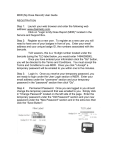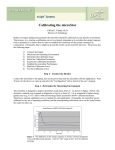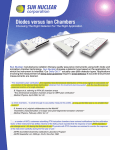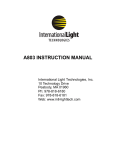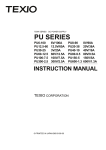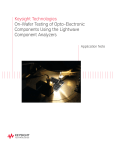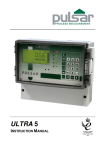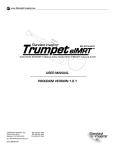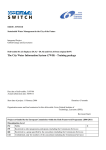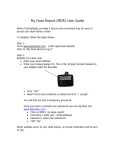Download MicroStar Reader QA Program
Transcript
microStar Reader Quality Assurance Program Medical Dosimetry Users Nicole T. Ranger, M.Sc. November 2, 2012 Senior Research Medical Physicist Confidential – Do Not Distribute 1 microStar Reader QA Program Overview Introduction – – – How does OSL dosimetry work ? MicroStar Reader Characteristics nanoDot Dosimeter Characteristics MicroStar Reader QA Program – – – – – – Manufacturing Tests Installation Testing Calibration Daily QC Preventive Maintenance Available Resources Troubleshooting, Customer Support & Service 2 microStar Reader QA Program INTRODUCTION 3 microStar Reader QA Program Introduction: The MicroStar Reader + Dosimeters Patient Dosimetry QA nanoDot Dosimeter nanoDot Dosimeter + reader adapter Environmental + Occupational Dosimetry InLight Dosimeter InLight Type 2 Personnel Dosimeter 4 microStar Reader QA Program Introduction: How does OSL dosimetry work ? The microStar reader and associated dosimeters utilize optically-stimulated luminescence (OSL) dosimetry technology. What is Optically-Stimulated Luminescence (OSL) ? 5 microStar Reader QA Program Introduction: How does OSL dosimetry work ? CONDUCTION BAND BAND GAP VALENCE BAND 6 microStar Reader QA Program Introduction: How does OSL dosimetry work ? CONDUCTION BAND ELECTRON TRAP LUMINESCENCE CENTER (RECOMBINATION) VALENCE BAND 7 microStar Reader QA Program Physics of Luminescent Dosimetry: Irradiation Dosimetric Traps Luminescence Centers 8 microStar Reader QA Program Physics of Luminescent Dosimetry: Thermal Stimulation Dosimetric Traps Luminescence Centers 9 microStar Reader QA Program Physics of Luminescent Dosimetry: Optical Stimulation Dosimetric Traps Luminescence Centers 10 microStar Reader QA Program Physics of Luminescent Dosimetry: OSLD vs. TLD OSLD TLD Electron/hole capture at site of dosimetric traps in crystalline structure Electron/hole capture at site of dosimetric traps in crystalline structure Optically-Stimulated Luminescence Thermally-Stimulated Luminescence Precision Very good Very good* Accuracy Very good to Excellent Very good* Fast Slow Multiple re-reads None, single-read only Low High Dose Deposition Readout Mechanism Readout speed Re-read capability Operational overhead (manhours, equipment) * Requires very stringent procedural controls to achieve good results 11 microStar Reader QA Program Physics of Luminescent Dosimetry: Electron Transitions A: Exposure + Charge separation: electron moves from valence band to conduction band CONDUCTION BAND B: Trapping of a hole at a deep hole trap. C: Electron capture/release at a superficial level electron trap (unstable at ambient temperatures , lifetime: sec. to min.). D: Electron capture at medium level “dosimetric” trap, released by applying optical stimulation. E: Electron capture at deep level trap; released only with high temperatures or UV light. F: Recombination of a hole and an electron and emission of light at a luminescence center C A B D F BAND GAP REGION E VALENCE BAND 12 microStar Reader QA Program Physics of Luminescent Dosimetry: Stimulation Modes OPTICAL STIMULATION MODES: (POSL vs. CW-OSL) Pulsed Optically Stimulated Luminescence (P-OSL) readers utilize a pulsed light source (laser or LED) and although accurate, are costly to manufacture due to gating electronics, high power laser cost, etc… - stimulation and emission spectra are temporally-separated Continuous Wave Optically Stimulated Luminescence (CW-OSL) readers employ Light Emitting Diodes (LEDs) that illuminate the Al2O3:C dosimeter continuously during readout. - cost effective: use inexpensive LEDs and do not require gating circuitry - optical filtration removes the majority of stimulation spectral components that would otherwise be transmitted and included in the emission (luminescence) spectra 13 microStar Reader QA Program Characteristics of the MicroStar Reader: How it works EXPANDED SCHEMATIC VIEW: OPTICAL CHAIN Additional Filters Photomultiplier Tube Optical Beam Aperture Green LED Light Source (5 mm diam.) Light Guide Filter on Swing OSL Arm Dosimeter Active Element Further details of filter specifications: Medical Physics, Vol. 34, No. 12, December 2007 (4 mm diam.) Filter pack STIMULATION SPECTRA: centered at 532 nm green EMISSION SPECTRA Centered at: 420 nm blue 14 microStar Reader QA Program Characteristics of the MicroStar Reader: How it works Expose Test Dosimeter to Radiation Electrons excited from Valence to Conduction Band Electrons Trapped at Crystal Defect Sites Photons Transmitted through optical filters to PMT Luminescence Photons Emitted Trapped Electron Releases with Optical Stimulation LED PMT Output Signal to Counting Circuit Software compares Test Dosimeter Counts to Reference Dosimeter Counts PMT + ELECTRONICS CALIBRATION Computed Dose Estimate 15 microStar Reader QA Program Characteristics of the MicroStar Reader: How it works SIMPLE LINEAR Medical Dosimetry [using the nanoDot dosimeter] Dose Calculation POLYNOMIAL FIT Dose Calculation Applications Environmental Occupational The signal from the test dosimeter is compared against that of calibration references that are independently verified (and ideally NIST-traceable). For best results the test and reference dosimeters should be irradiated under comparable conditions (radiation quality, geometry relative to source and scattering conditions, etc…). 16 microStar Reader QA Program Characteristics of the MicroStar Reader: How it works When the LINEAR CALIBRATION mode is enabled when reading test dosimeters, the DOSE is computed using the following expression: PMT_Counts Dose(cGy) CALFACTOR( counts/dose) SENSITIVIT Y PMT_Counts are background-corrected (as necessary) SENSITIVITY is the “relative” EFFICIENCY of the TEST dosimeter in comparison to the reference population and is a dimensionless factor 17 microStar Reader QA Program Characteristics of the MicroStar Reader: How it works THE LINEAR CALIBRATION FACTOR IS GIVEN BY THE FOLLOWING: 1 L 1 1 N R C n,r, l CALFACTOR BKGD av g L l1 E1 N * R n1 r 1 S n where: 1 N R C n,r,l0 BKGD avg N * R n1 r 1 S n E = Dose l = lth dose level, l=1...L where L = # dose levels in the range l0 = 0th dose level for unexposed dosimeters n = nth dosimeter, n=1…N where N = # dosimeters per dose level Sn = sensitivity of nth dosimeter r = rth dosimeter reading; r=1…R where R=# of readings per individual dosimeter C n,r,l = rth reading of nth dosimeter at lth dose level Cn,r,l0 = rth reading of nth dosimer at “unexposed” dose level 18 microStar Reader QA Program Characteristics of the MicroStar Reader: How it works UNDERLYING ASSUMPTIONS 1. “Unexposed” test and/or Calibration reference dosimeters are read prior to use to ensure no significant accumulated dose due to natural background or inadvertent exposure. 2. Test and Calibration dosimeters are exposed under comparable conditions, i.e. radiation energy & exposure geometry/conditions. 3. Test dosimeters have been read at least 10 minutes after irradiation and before signal fading effects might impact accuracy. 4. Reader response is required to be relatively constant over time. Must maintain stable temperature environment, monitor performance metrics, and recalibrate reader as necessary. 19 microStar Reader QA Program Characteristics of the MicroStar Reader HARDWARE OVERVIEW: EXTERNAL Carrier Plate LED “ON” Indicator Light Adapter or Holder Measurement Dial Tray Drawer Carrier 20 microStar Reader QA Program Characteristics of the MicroStar Reader HARDWARE OVERVIEW: EXTERNAL Power Switch USB Port Power Input Cooling Fan 21 microStar Reader QA Program Characteristics of the MicroStar Reader HARDWARE OVERVIEW: EXTERNAL H/P: Home Position (START) To acquire a single reading of a nanoDot : 1. Rotate dial CLOCKWISE (right) so that arrow points from H/P to E1. 2. Pause until LED ON Indicator turns off 3. Rotate back COUNTERCLOCKWISE (left) back to the home position H/P. 22 microStar Reader QA Program Characteristics of the MicroStar Reader HARDWARE OVERVIEW: EXTERNAL H/P: Home Position (START) To acquire a series of reader Standard Measurement (DRK, CAL, LED) readings: 1. Rotate dial COUNTERCLOCKWISE (left) from home position (H/P) to DRK, CAL & LED, pausing 1 second at each position until the LED ON Indicator light turns off 2. Rotate the dial CLOCKWISE (right) back to the home position H/P. 23 microStar Reader QA Program Characteristics of the MicroStar Reader STANDARD MEASUREMENTS INTRINSIC reader performance metrics that are designed to reflect the reader response stability by assessing the PMT signal in response to “STANDARD” stimuli. They do not fully represent the conditions under which medical dosimetry measurements with a nanoDot are taken and therefore should NOT be used to adjust or correct readings. DRK: PMT response to NO stimulus which is an indicator of electronic noise or “dark current”. CAL: PMT response to a small exempt quantity of C-14 (T½ = 5730 years) encapsulated in a powdered phosphor LED: PMT response to the LED source used to stimulate OSLDs during readout but with filter closest to the LED retracted. 24 microStar Reader QA Program Characteristics of the MicroStar Reader PMT Saturation at High Doses and Counting Errors at Low Doses are Limiting Conditions 100% 1000000 75% 10000 50% Counts Error 100 25% 10,000,000 Dose (mrad or 10 -3 cGy) 1,000,000 100,000 10,000 1,000 100 10 0% 1 1 Counting Error (%) RAW PMT Counts (E1) OPERATING RANGE & PMT GAIN 25 microStar Reader QA Program Characteristics of the MicroStar Reader SOLUTION: DYNAMIC RANGE CONTROL Range of the PMT is extended by using two different operating (gain) modes with different optical stimulation levels: WEAK BEAM (High Doses) & STRONG BEAM (Low Doses); Cross-Over-Point (COP) defines transition between both operating ranges. Range is selected “on the fly”. When a test dosimeter is analyzed: – The PMT counts obtained with a brief (0.1s) flash of light (same as pretest counting duration) are compared with the pretest counts obtained at the cross-over point (COP) dose to determine if the “Weak” beam or the “Strong” beam readout mode is to be used. – The appropriate level of stimulation (Weak or Strong) is then selected and applied for a duration of 1.0 second during which the luminescent signal is collected. Provides for a wide dynamic range – 5 mrem LLD (Occupational Dosimetry) to 15 Gy (Radiation Oncology) 26 microStar Reader QA Program Characteristics of the MicroStar Reader Average - Background & SensitivityCorrected PMT CTS READER RESPONSE & CROSS-OVER-POINT (COP) Corrected MicroStar PMT Counts vs. Calibrated NanoDot Dose: LOW (left of COP) and HIGH (right of COP) Dose Regions 200,000 COP ≈ 12000 mrad (12 cGy) 150,000 LD_CALFACTOR = 11.599 CTS/MRAD HD_CALFACTOR = 0.802 CTS/MRAD 100,000 Low Dose Calib Data High Dose Calib Data 50,000 0 0 20,000 40,000 60,000 80,000 100,000 120,000 140,000 160,000 180,000 200,000 220,000 Calibrated Dose (mrad or 10-3 cGy) 27 microStar Reader QA Program Physical Characteristics of the nanoDot OSL Dosimeter How is the nanoDot manufactured ? • High purity Al2O3 is melted at high temperatures and recrystallized after the addition of dopants, resulting in the formation of oxygen vacancies, thus creating a unique crystalline structure that is able to trap electrons released from the valence band when the crystal is exposed to radiation. • The Al2O3:C is then formulated as a powder mixed with a liquid binder, before being coated onto a base material and sealed with a transparent film tape. Individual nanoDots are punched out from these rolls of Al2O3:C and are then encapsulated in a plastic light-tight case. 28 microStar Reader QA Program Physical Characteristics of the nanoDot OSL Dosimeter OPEN BAR CODE OSL Dosimeter: Disk of Al2O3:C 4 mm diameter 0.3 mm thick CLOSED SERIAL # (of which 0.2 mm is Al2O3:C) ρ = 3.95 - 4.10 g/cm3 + FRONT nanoDot Outer Case: Square- ABS Plastic 10.0 x 10.0 mm 2.0 mm thick (0.36 mm thick above/below Al2O3:C) ρ = 1.03 + BACK g/cm3 NOTE: Asymmetric position of dosimeter within case 29 microStar Reader QA Program Dosimetric Performance of the nanoDot OSL Dosimeter RESPONSE RELATIVE TO WATER Kerns / RPC 30 microStar Reader QA Program Dosimetric Performance of the nanoDot OSL Dosimeter NANODOT SENSITIVITY LABELING Serial #: DN091042837 Sensitivity = 0.91 The 3 digits appearing after the two-letter Alphabetic code (e.g. “DN”) designate the nanoDot labeled sensitivity which is used in the reader dose calculation and is now decoded automatically by the v4.3 software when the nanoDot barcode serial number is scanned when performing a reading. 31 microStar Reader QA Program Dosimetric Performance of the nanoDot OSL Dosimeter GENERAL PURPOSE (GP) VS. SCREENED NANODOTS For General Purpose (GP) nanoDots the sensitivity is assigned based on the POPULATION, i.e. the measured average sensitivity of the OSL roll from which nanoDots are extruded; all nanoDots originating from the same roll are assigned the same sensitivity value (but have unique SNs). For Screened (S) nanoDots the sensitivity is based on an INDIVIDUAL test nanoDot’s measured sensitivity wherein the nanoDot’s response to a calibrated (NIST-traceable) exposure at 5 Rads (Cs-137; 662 keV) is compared with that of REFERENCE nanoDots whose sensitivity is known to a high degree of accuracy & precision. The test nanoDot is then labeled, re-exposed and re-read to verify the labeled sensitivity, then annealed prior to release to inventory. 32 microStar Reader QA Program Dosimetric Performance of the nanoDot OSL Dosimeter SCREENED NANODOT SENSITIVITY ASSIGNMENT Sn = CT: raw counts TEST nanoDots CREF: raw counts TEST nanoDots n: nth test nanoDot dosimeter m: mth reference dosimeter M: total # reference dosimeters Sn: sensitivity of n-th TEST nanoDot Sm: sensitivity of m-th reference dosimeter r: rth reading for single dosimeter R: total # reading repetitions 33 microStar Reader QA Program Dosimetric Performance of the nanoDot OSL Dosimeter GENERAL PURPOSE (GP) VS. SCREENED NANODOTS SENSITIVITY RANGE GP nanoDots™ SCREENED nanoDots™ 0.75 – 1.10 0.75 – 1.10 ASSIGNMENT METHOD Population: Manufacturer labels all nanoDots™ extruded from a roll of OSL material based on the LDRsupplied measured average sensitivity for that roll. Individual: Single unlabeled GP nanoDot™ received from manufacturer undergoes sensitivity assignment and once labeled is retested to verify accuracy of labeled sensitivity MEASURED BY LDR QC Department (Roll) LDR QC Department (nanoDot) LABELED BY GP nanoDot™ manufacturer LDR QC Department 34 microStar Reader QA Program Factors Impacting nanoDot™ Dose Accuracy 1. 2. 3. 4. 5. 6. 7. Accuracy of nanoDot™ labeled sensitivity nanoDot™ physical/mechanical integrity nanoDot™ adapter integrity Reader LED/PMT & general electronic stability over time Accuracy of reference calibration doses & resulting calibration factors Number of single nanoDot™ readings obtained/averaged for reading Use of multiple nanoDots™ for one measurement condition 35 microStar Reader QA Program Dosimetric Performance of the nanoDot OSL Dosimeter Recommended Analytical Measurement Procedures (RAMPs) Use a common nanoDot adapter for both calibration, calibration verification and all subsequent readings and SCREENED nanoDots™ Use calibration nanoDots irradiated to a KNOWN prescribed dose (ideally NIST-traceable) using a clinical radiation beam spectra and phantom geometry that emulates that of intended application (e.g. dmax, etc..) Read nanoDot(s) four (4) times; reject outlier if necessary Read nanoDots between 10 minutes and 360 minutes post irradiation Implement Landauer-recommended MicroStar QA Program 36 microStar Reader QA Program Dosimetric Performance of the nanoDot OSL Dosimeter NANODOT PERFORMANCE SPECIFIED GP nanoDots™ SCREENED nanoDots™ ACCURACY PRECISION ± 10% ± 5% ± 5% ± 5% PUBLISHED: 01/2012 NOTE: Specifications above reflect expected DOSIMETRY performance when Recommended Analytical Measurement Procedures (RAMPs) are followed. (k=2; 95% confidence) 37 microStar Reader QA Program Dosimetric Performance of the nanoDot OSL Dosimeter WARNING ! Exposure to visible light will reduce the measured signal of unprotected aluminium oxide. Care must be taken to ensure the dosimeter is not mishandled or inadvertently opened after radiation exposure prior to readout. If dosimeters are not read immediately care should be taken to ensure they are not subject to extreme environmental conditions during transport or storage. Ultraviolet light will induce measurable signal for unprotected aluminium oxide. Take precautions to avoid subjecting unexposed dosimeters to unfiltered UV light sources either during storage or when performing an optical anneal operation. 38 microStar Reader QA Program Dosimetric Performance of the nanoDot OSL Dosimeter NANODOT SENSITIVITY & ACCUMULATED DOSE Best Practice: Remove nanoDots from service when lifetime dose > 10 Gy P. Jursinic, Med Phys 34(12), 4594-4604. 39 microStar Reader QA Program Dosimetric Performance of the nanoDot OSL Dosimeter RELATIVE RESPONSE WITH PHOTON ENERGY nanoDot Energy Response Relative to that at 662 keV (Cs-137) [ on 30 x 30 x 15 cm acrylic phantom ] Relative Response 4.5 4.0 3.5 3.0 Response Relative to Cs-137 (662 keV) 2.5 2.0 1.5 1.0 0.5 0.0 0 100 200 300 400 500 600 700 Average Energy (keV) 40 microStar Reader QA Program Dosimetric Performance of the nanoDot OSL Dosimeter RELATIVE RESPONSE WITH PHOTON ENERGY nanoDot Energy Response Relative to that at 80 kVp (44 keV) [ on 30 x 30 x 15 cm acrylic phantom ] Diagnostic Energy Range: 20 – 120 keV Relative Response 1.2 1.0 0.8 0.6 0.4 Response Relative to RQR6 (80 kVp or 44 keV) 0.2 0.0 0 20 40 60 80 Average Energy (keV) 100 120 140 41 41 microStar Reader QA Program Dosimetric Performance of the nanoDot OSL Dosimeter LINEARITY OF RESPONSE WITH DOSE AT 6 MV For most radiation therapy applications response is linear < 200-300 cGy P. Jursinic, Med Phys 34(12), 4594-4604. 42 microStar Reader QA Program Characteristics of the MicroStar Reader For doses > 300 cGy, a best fit to the average sensitivity- and backgroundcorrected PMT counts versus dose can be established using a 2nd order polynomial fit yielding the calibration coefficients (CALFACTORS) a, b, & c in a quadratic expression having the form: Dose (cGy) aX 2 bX c where X = the average sensitivity- and background-corrected raw PMT counts at a given dose level. Units for a, b & c when dose units are “cGy” are: cGy/counts2 (a), cGy/counts (b), & cGy (c), respectively 43 microStar Reader QA Program Characteristics of the MicroStar Reader Therapeutic Energy Range: 6 MV - 18 MV; 6 MeV - 20 MeV Minimal Energy Dependence P. Jursinic, Med Phys 34(12), 4594-4604. Minimal Angular Dependence 44 microStar Reader QA Program Characteristics of the MicroStar Reader Therapeutic Energy Range: 6 MV - 18 MV; 6 MeV - 20 MeV Minimal Temperature Dependence P. Jursinic, Med Phys 34(12), 4594-4604. Minimal Dose-Rate Dependence 45 microStar Reader QA Program Dosimetric Performance of the nanoDot OSL Dosimeter SIGNAL RETENTION / FADING Under normal handling and environmental conditions the signal loss due to spontaneous depopulation of traps is expected to be less than 2% over 6 months, or no more than 4% signal fade over 12 months based on extrapolation of the observed rate of fading. OSL Dosimeter Dose/Signal Retention 100.8% Measured Extrapolated 100.0% 99.2% Normalized 98.4% Response 97.6% 96.8% 96.0% 0 60 120 180 240 300 360 Days Elapsed Post-Irradiation 46 microStar Reader QA Program Dosimetric Performance of the nanoDot OSL Dosimeter SIGNAL DEPLETION DUE TO READOUT Using an optical stimulation of 1.0 sec. duration (reader default), typical depletion rates per individual reading are: 0.05 % High Doses (Weak Beam) > Cross-Over-Point (> ~ 15 cGy) 0.5% Low Doses (Strong Beam) < Cross-Over-Point (< ~ 15 cGy) IMPORTANT: Cross-Over-Point can now be changed by customer in v4.3 and radiation therapy customers can now force a low illumination readout mode (0.05% depletion per reading) for all readings regardless of dose. 47 microStar Reader QA Program MICROSTAR READER QA PROGRAM MEDICAL DOSIMETRY USERS 48 microStar Reader QA Program MOTIVATION 49 microStar Reader QA Program Quality Assurance Continuum Quality Assurance is a Process and needs to be addressed at each stage of implementation 50 microStar Reader QA Program Emulates Medical Device “Best Practices” I. Manufacturer In-house QC Tests II. On-site Clinical Installation/Acceptance Tests III. On-going DAILY/MONTHLY/ANNUAL Performance Testing / Monitoring IV. Periodic Preventive Maintenance including: Cleaning, Re-Calibration &/or Repair (as indicated) 51 microStar Reader QA Program Requirement for Continuous Performance Monitoring I LANDAUER IN-HOUSE QC TESTS III / IV CUSTOMER IMPLEMENTS LANDAUERRECOMMENDED MICROSTAR QA II MONITORING + ON-SITE PREVENTIVE CALIBRATION & INSTALLATION TESTING MAINTENANCE M O N I T O R I N G PROCEED WITH CLINICAL DOSIMETRY APPLICATIONS USING NANODOTS AND THE MICROSTAR READER PROGRAM 52 microStar Reader QA Program Control Limits The MicroStar QA Program for Medical Dosimetry Users now utilizes Control Limits for all specified tests in order to establish clear criteria for determining whether the reader is performing at acceptable levels for this application. 53 microStar Reader QA Program Mandatory Performance Thresholds I LANDAUER IN-HOUSE QC TESTS III / IV CUSTOMER IMPLEMENTS LANDAUERRECOMMENDED MICROSTAR QA II MONITORING + ON-SITE PREVENTIVE CALIBRATION & INSTALLATION TESTING MAINTENANCE M O N I T O R I N G DISCONTINUE USE IF MICROSTAR READER DOES NOT MEET MANDATORY PERFORMANCE THRESHOLDS PROGRAM 54 microStar Reader QA Program Requirement for Continuous Performance Monitoring I LANDAUER IN-HOUSE QC TESTS III / IV CUSTOMER IMPLEMENTS LANDAUERRECOMMENDED MICROSTAR QA II MONITORING + ON-SITE PREVENTIVE CALIBRATION & INSTALLATION TESTING MAINTENANCE M O N I T O R I N G PROCEED WITH CLINICAL DOSIMETRY APPLICATIONS USING NANODOTS AND THE MICROSTAR READER PROGRAM 55 microStar Reader QA Program Manufacturing Tests In-Light Dosimeters ① ② ③ ④ ⑤ ⑥ Establish Cross-Over Point (COP) MicroStar Calibration Linearity of Response with Dose Level Reading Reproducibility Lowest Level of Detection (LLD) Reading Depletion Rate: Strong & Weak Beam Mode 56 microStar Reader QA Program Manufacturing Tests Intrinsic (No Dosimeter Required) ⑦ Standard Measurements (Electronics, PMT & LED Stability) ⑧ Light Leakage (Physical integrity of reader housing) 57 microStar Reader QA Program Manufacturing Tests nanoDot Dosimeters ⑨ Cross-Over Point (COP) (PENDING) ⑩ NanoDot Reading Reproducibility: • 5 nanoDots, new adapter/key plate, 2 new adapters EACH MICROSTAR READER MUST PASS ALL MANUFACTURING TESTS IN ORDER TO BE SHIPPED 58 microStar Reader QA Program Manufacturing Test Summary Report Sheet Reader Serial # Test Date Calibration Factors at 662 keV: - Low Dose Range - High Dose Range Factory-Established Cross-Over Point Standard Measurements: - DRK (Max) - CAL (Avg./CV) - LED (Avg./CV) Lowest Level of Detection (LLD) 59 microStar Reader QA Program Installation Protocol + Tests MicroStar™ Reader DX & TX Users ① ② ③ ④ ⑤ ⑥ ⑦ Unit arrives on-site, is unpacked & setup Thermal stabilization (1-24 hours) Electronic stabilization (at least 30 min.) Reader stability: 20 cycles of standard measurements nanoDot reading reproducibility with each adapter Calibration using 80 kVp (DX, TX users optional) Accuracy in dose readings (post-calibration QC test) 60 microStar Reader QA Program Installation Tests MicroStar™ Reader TX Users only ⑧ Clinical Beam Calibration + Verification - Application-specific calibration & post-calibration verification using clinical beam spectra when prescribed dose is known to reasonable accuracy, i.e. in radiation therapy - RESOURCE: White Paper - “Calibrating the microStar” 61 microStar Reader QA Program Geometry for Standard Therapy Calibration Exposure geometry must be consistent with that recommended by Landauer in the microStar white paper: “Calibrating the microStar Reader” 10+ cm thick solid water Phantom centered on beam axis such that surface is at an SSD of 100 cm . 3-4 unexposed screened nanoDots are positioned at beam center on flexible solid water slab Additional thicknesses of solid water added to achieve a total overlying thickness of dmax. Typically 6 MeV photon beam is used (dmax=1.5 cm). 62 microStar Reader QA Program Therapy Calibration Protocols: How to Choose ? NANODOT IS USED TO MEASURE DOSES LESS THAN 300 cGy - USE LINEAR CALIBRATION Single Use NANODOT IS USED TO MEASURE DOSES GREATER THAN 300 cGy – USE NON-LINEAR CALIBRATION For dosimetry applications in the Megavoltage Range , how will you use the nanoDot ? NANODOT IS ANNEALED BETWEEN USES AND DOSES ARE LESS THAN 300 cGy - USE LINEAR CALIBRATION * Re-Used NANODOT IS NOT ANNEALED BETWEEN USES – USE NON-LINEAR CALIBRATION ** * nanoDot cummulative dose must be monitored to ensure lifetime dose does not exceed 10 Gy. ** This mode is not generally recommended because of the increasing variance in successive readings as predicted by the rules for error propagation: When using mathematical expressions to compute a result, the result will always have a variance greater than the largest variance in the individual variables used in the expression calculation. 63 microStar Reader QA Program Therapy Megavoltage Calset created by customer Recommended Default Dose Levels Linear Calibration (use for Doses < 300 cGy): Low Dose Range (<15 cGy): unexposed, 5 cGy, 10 cGy High Dose Range (> 15 cGy): 50, 100, 200, (300 optional) cGy NOTE: If the COP is lowered such that a 10 cGy dose falls in the HIGH DOSE range, a separate low dose calibration is not required: Add unexposed ,5 cGy, and 10 cGy dose levels to high dose levels. Non-Linear Calibration (use for Doses > 300 cGy): High Dose Range: 50, 100, 300, 500, 800, 1000, 1300 cGy These default dose levels are provided for instructional purposes. It is the user’s responsibility to select a dose calibration protocol that is most appropriate for their clinical application. Contact Landauer Customer Service for additional guidance. 64 microStar Reader QA Program Guidelines when using Calibration/QC nanoDots For microStar calibrations performed using a Landauer-supplied CALSET, dose level must be obtained from the Calibration Certificate. Calibration & QC (Calibration verification) nanoDots are not to be used for other purposes to avoid inaccurate calibration due to depletion effects. Frequency of use of CAL/QC nanoDots needs to be tracked to avoid excessive depletion which can impact accuracy. Calsets will have a finite lifetime before they should be retired – recommended lifetime for Calsets used in medical dosimetry is no longer than SIX MONTHS. Calsets reused often may need to be replaced sooner. 65 microStar Reader QA Program Guidelines for Calibration Frequency MINIMUM - At installation - After repair / service - Whenever QC/Accuracy Test Fails IDEALLY* - On a regular/proactive schedule 66 microStar Reader QA Program ROUTINE QUALITY CONTROL 67 microStar Reader QA Program Daily QC Tests MicroStar™ Reader Daily QC Tests DX & TX Users ① ② ③ ④ Warm-up (at least 30 min.) 5 Cycles of Standard Measurements nanoDot reading reproducibility (10 sequential readings) Constancy nanoDot reading (OPTIONAL) Aside from the warmup period, the actual test protocol takes less than 5 minutes to complete. 68 microStar Reader QA Program Daily QC Tests NANODOT READING REPRODUCIBILITY TEST SUPPORTED in v4.3 SOFTWARE USING “REPEATABILITY TEST WINDOW” 69 microStar Reader QA Program Monitoring Reader Performance Trends PERFORMANCE METRICS THAT SHOULD BE MONITORED OVER TIME FOR TRENDS 1. STANDARD MEASUREMENT RESULTS (DAILY & OTHER) 2. DAILY CONSTANCY NANODOT (OPTIONAL) 3. CALIBRATION FACTORS BY ENERGY, DOSE RANGE 70 microStar Reader QA Program Example: Monitoring Trends in Daily QC Readings 71 microStar Reader QA Program RESOURCES 72 microStar Reader QA Program RESOURCES: Landauer MicroSite (WIP – See Updates) Electronic version of Manuals & Procedure Flow Charts QC Forms QC Report Spreadsheets Viewable “Click Through” Educational Presentations “How to” Instructional Videos Technical White Papers Clinical Application Guides Self-study resource list: peer-reviewed publications & books MicroStar Training Certification via Post-Training Self-Test FAQ & Trouble-shooting Guidelines 73 microStar Reader QA Program RESOURCE: Installation Testing Flow Charts 74 microStar Reader QA Program RESOURCE: Installation Testing Flow Charts 75 microStar Reader QA Program RESOURCE: Installation Testing Flow Charts 76 microStar Reader QA Program RESOURCE: Standard Measurements Work Sheet 77 microStar Reader QA Program RESOURCE: Installation Testing Flow Charts 78 microStar Reader QA Program RESOURCE: Standard Measurements Log Sheet 79 microStar Reader QA Program RESOURCE: Installation Testing Flow Charts 80 microStar Reader QA Program RESOURCE: nanoDot Reading Reproducibility Form 81 microStar Reader QA Program RESOURCE: Installation Testing Flow Charts 82 microStar Reader QA Program RESOURCE: Installation Testing Flow Charts 83 microStar Reader QA Program RESOURCE: Calibration Report Form 84 microStar Reader QA Program RESOURCE: Installation Testing Flow Charts 85 86 microStar Reader QA Program RESOURCE: Calibration Log Sheet 87 88 microStar Reader QA Program RESOURCE: Daily QC Testing Flow Chart 89 90 microStar Reader QA Program RESOURCE: Daily QC Form 91 microStar Reader QA Program Monitoring Reader Performance Trends Obtain a series of FIVE (5) Standard Measurements Export Data from MicroStar to Excel Verify results are within limits (DRK < 20, CVCAL & CVLED < 0.05) Record result on Daily QC form Add data to Excel Trend Report Monitor trends Printable Retrospective Daily Standard Measurements Trend Report 93 microStar Reader QA Program RESOURCE: QA Forms - Printable (.PDF) or Electronic (.XLS) ① ② ③ ④ ⑤ ⑥ ⑦ ⑧ ⑨ High Precision MicroStar Standard Measurement Record Sheet MicroStar Standard Measurement Control Limits Log nanoDot Reading Reproducibility Record Sheet Linear Calibration Worksheet Calibration Log Sheet Non-Linear Calibration Worksheet Non-Linear Calibration Log Sheet Reader Daily Quality Control Log Sheet Calibration Set Usage Log Sheet 95 microStar Reader QA Program RESOURCE: QA Report Spreadsheets ① ② ③ ④ ⑤ ⑥ ⑦ ⑧ High Precision Standard Measurements Test: 20 cycles Daily QC Standard Measurements Trend: 5 cycles nanoDot/Adapter Reading Reproducibility Linear Calibration Verification Non-Linear Calibration Verification Trends in Computed Calibration Factors Trends in Constancy nanoDot readings (optional) Post-Calibration/QC reading trends (weekly – monthly) 96 microStar Reader QA Program Future Calset Options for Medical Dosimetry Users Calibration Using Landauer NIST-Traceable Reference Dosimeters Will the nanoDots & microStar be used for dosimetry at Diagnostic (DX) or Therapeutic (TX) energies ? DX Perform linear calibration of the reader using the Landauer-supplied 80 kVp Calset TX Perform linear calibration of the reader using the Landauer-supplied Cs-137 (662 keV*) Calset * The 662 keV TX therapy provides a set of reference dosimeters irradiated under controlled conditions that can be used to verify the MicroStar performance independent of clinical systems but should not be used for clinical dosimetry. 97 microStar Reader QA Program RESOURCE: Landauer-supplied 80 kVp nanoDot Calset NOTE: New Calset Configuration – Available 1st quarter 2013 CALIBRATION SET Prior Dose Levels (cGy*) New Dose Levels (cGy*) Unexposed Unexposed Low 0.5 1.0 Low 3.0 10.0 Low 50.0 50.0 High 100.00 High Prior Dose Levels (cGy*) New Dose Levels (cGy*) Dose Range Unexposed Unexposed Low 1.0 1.0 Low 100.00 High 100.00 POST-CAL QC SET Dose Range - using Unit Conversion: 1 cGy = 1000 mrad; Dose Range designation when Cross-Over-Point (COP) default setting is unchanged. 98 microStar Reader QA Program RESOURCE: Landauer-supplied 662 keV nanoDot Calset NOTE: New Calset Configuration – Available 1st quarter 2013 CALIBRATION SET POST-CAL QC SET Dose (cGy*) Dose Range Dose (cGy*) Dose Range Unexposed Low 1.0 Low 50.0 High 5.0 Low 100.0 High 10.0 Low 200.0 High Dose (cGy*) using Dose Range Dose (cGy*) Dose Range Unexposed Low 1.0 Low 50.0 High 10.0 Low 200.0 High Unit Conversion: 1 cGy = 1000 mrad; Dose Range designation when Cross-Over-Point (COP) default setting is unchanged. 99 microStar Reader QA Program RESOURCE: Bibliography of Peer-Reviewed Publications Examples: Jursinic PA, “Changes in optically stimulated luminescent dosimeter (OSLD) dosimetric characteristics with accumulated dose.”, Med Phys 37(1): 132-140, (2010). Jursinic PA, “In vivo dosimetry with optically stimulated luminescent dosimeters, OSLDs, compared to diodes; the effects of buildup cap thickness and fabrication material, Med Phy 38(10), 5432-5440,(2011). 100 microStar Reader QA Program SCHEDULED PREVENTIVE MAINTENANCE & SERVICE 101 Landauer Customer Service Contact Info 800-561-2708 or: [email protected] 102 microStar Reader QA Program TROUBLESHOOTING SUPPORT 103 microStar Reader QA Program Recommended approach to trouble-shooting 1. Consult the Landauer User Manual 2. Consult the MicroStar MicroSite Frequently Asked Question (FAQs) section 3. Contact Landauer Customer Service by phone: 800-561-2708 by email: [email protected] How your inquiry will be routed: General Issues: Mechanical/Software: Advanced Applications: Customer Service Rep InLight Product Specialist Medical or Health Physicist 104 microStar Reader QA Program W-I-P: Trouble-shooting and Clinical Application Videos A family of training videos specific to medical dosimetry users & medical dosimetry clinical applications are being planned. Watch for announcements on the Landauer MicroSite: http://solutions.landauer.com/microstar 105 microStar Reader QA Program DOCUMENTING READER ISSUES 106 microStar Reader QA Program Trouble-Shooting: WARNING The Landauer User Manual includes instructions on how to perform simple mechanical trouble-shooting. You are not obligated to perform these mechanical interventions. You have the option of sending your reader back for repair by contacting customer service at: 1-800-561-2708 If you attempt to un-jam the reader, follow all instructions. TURN OFF AND UNPLUG reader before opening!!! 109 microStar Reader QA Program How to Ensure Accuracy in Medical Dosimetry Results BEST PRACTICES: Implement the MicroStar QA Program and monitor reader performance trends. Recalibrate the reader as indicated by periodic Post-Cal QC verification tests. Verify the correct sensitivity is displayed when scanning nanoDot serial numbers prior to reading. When reading nanoDots, note the form of the dose calculation formula on the reading screen and that the values used in the calculation are correct. Always use the average of 3-4 readings to calculate an average estimate of dose for medical dosimetry applications, never rely on a single reading. Manually verify any suspect dose results. 110 microStar Reader QA Program Recommended QA Test Frequency DESCRIPTION OF TEST FREQUENCY STANDARD MEASUREMENTS TEST (5) DAILY NANODOT READING REPRODUCIBILITY DAILY NANODOT READING CONSTANCY DAILY (OPTIONAL) CALIBRATION INSTALLATION / AFTER REPAIR / AS INDICATED ESTABLISH/VALIDATE CONTROL LIMITS AT INSTALLATION / AFTER REPAIR INSTALLATION TESTS MONITORING OF TRENDS IN QA TEST RESULTS AT INSTALLATION / ANNUALLY / AFTER REPAIR ONGOING 111 microStar Reader QA Program FREQUENTLY ASKED QUESTIONS (FAQs) 112 microStar Reader QA Program Frequently Asked Questions (FAQs) FAQ #1: I have v2.0 software. Is it really necessary that I upgrade to v4.3 ? There are a substantial number of benefits to upgrading to the v4.3 software, some of which are: 1. The nanoDot serial number is now automatically decoded, minimizing errors resulting from the possible use of an incorrect default nanoDot sensitivity. 2. There are new functions that facilitate the implementation of the new MicroStar Quality Assurance Program. 3. There are significant new features including the ability to save report export templates, to create site-specific demographics fields and security features. 4. Most importantly – at the end of Q1 2013, the v2.0 software will no longer be supported. 113 microStar Reader QA Program Frequently Asked Questions (FAQs) FAQ #2: Is the MicroStar Quality Assurance Program mandatory ? Landauer recognizes that individual medical physicists may opt to deviate from or adapt some of the recommended QA program recommendations as they customize their reader QA program to their specific application. However, Landauer strongly recommends that the default installation protocol and basic reader QA regimen be followed in order to achieve optimal results using the microStar reader. Furthermore, failure to perform the recommended installation protocol and QA tests to verify compliance with mandatory control limits will make it less likely to achieve the accuracy levels referenced on Landauer’s nanoDot specification sheet and consequently Landauer cannot be held responsible for results obtained when the reader is operated under those conditions. 114 microStar Reader QA Program Frequently Asked Questions (FAQs) FAQ #3: After installing v4.3, immediately after performing a reader calibration and then the post-calibration verification by performing a test dosimeter (QC) reading on the reading screen, the calibration factor displayed in the dose computation formula is displayed as “0” but the computed dose displayed appears to be correct. Also, the problem goes away with subsequent readings. Is this normal ? This is a known defect in this initial release of the v4.3 software. Rest assured that the correct value of the calibration factor is being used in the dose calculation formula which you can verify by performing a second reading. Since the standard protocol for medical dosimetry readings is to repeat the reading four times, this software defect is not expected to significantly impact users but will be addressed at the first opportunity in subsequent updates of the v4.3 software. 115 microStar Reader QA Program Frequently Asked Questions (FAQs) FAQ #4: My Average of 5 Standard Measurement Daily QC results measured over a year show a CAL result that is trending down by about 10% in comparison with the start of the year, while the PMT trend remains fairly constant. Is this normal ? Normally the CAL readings which reflect PMT response to a long-lived C-14 source should be very stable over the course of a year due to the long half-life of C-14 and if they did show a consistent downtrend that was due to decreased PMT response, it would be likely that the LED readings would show the same general trends. The fact that the CAL & LED trends show differing trend result implies there is something intrinsic to the CAL data acquisition that might impact those results alone. A likely explanation might be a buildup of dirt/dust on the swing arm filter that is otherwise retracted for LED readings. The recommended corrective action is to clean the filter. If cleaning the filter does not resolve the problem, the reader should be returned to Landauer for preventive maintenance. 116 microStar Reader QA Program Frequently Asked Questions (FAQs) FAQ #5: My nanoDot/Adapter Reading Repeatability test is consistently yielding CV results above 1.0%, e.g. 1.5-2.1 % but this test was yielding acceptable results until recently. What is the recommended course of action ? The consistency of nanoDot readings is highly dependent on both the reader operating stability which is reflected in the Standard Measurement results AND the mechanical stability of the nanoDot feed mechanism which is highly dependent on the state of the nanoDot adapter. First verify that the Daily 5 Standard Measurement QC Test results are acceptable. If so, repeat the nanoDot/Adapter Reading Repeatability test with the backup adapter (you should have received two with your reader). If the test passes, install the new adapter and label the prior adapter as defective and remove it from clinical use. Contact Landauer CS to order an additional backup adapter. In the event the adapter change does not resolve the problem, call Landauer Customer Service for additional guidance. 117 microStar Reader v4.3 Software Frequently Asked Questions (FAQs) FAQ #6: I notice that when I export dosimetry data + calibrations to MicroSoft Excel, that the magnitude of the calibration factor is always the same regardless of the selected units prior to export. However, the label on the calibration worksheet agrees with the chosen units for data export. What is going on ? This is a recently discovered v4.3 software defect that is still being investigated. The calibration factor is being exported in units of mrad ALWAYS even when other export units are selected. The label of the calibration worksheet is therefore only correct when mrad units have been selected prior to export. There are TWO options: 1. Export data in mrad units ALWAYS to avoid this issue. 2. If there is an absolute need to export data in other, for instance cGy units, proceed with the export and go to the Calibration tab in the exported file and compare the magnitude of the calibration factors with that recorded in the MicroStar software and adjust the magnitude in Excel so that it is in agreement while also verifying that the worksheet labeled units are correct, in this case “Calibration (cGy)”. 118 microStar Reader QA Program For additional FAQs, news & product updates, consult the Landauer MicroSite at: http://solutions.landauer.com/microstar 119 microStar Reader QA Program QUESTIONS OR COMMENTS ? 120 NEED ASSISTANCE ? For specific questions regarding your microStar® dosimetry system, please contact Landauer’s InLight® customer service division at: 800-561-2708 or: [email protected] A Landauer technical representative will be happy to assist you and will direct your questions to a medical or health physicist, as necessary. 121

























































































































